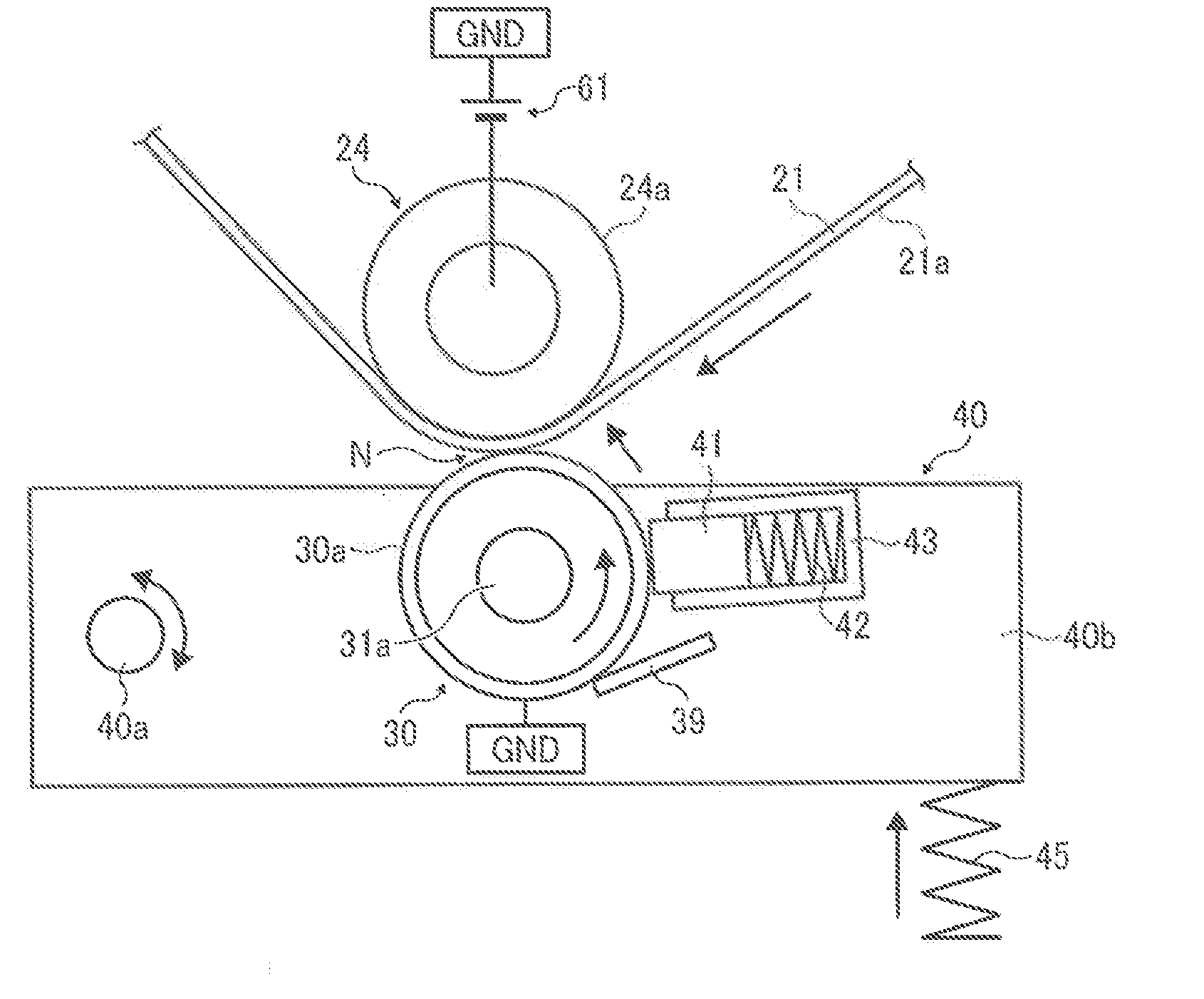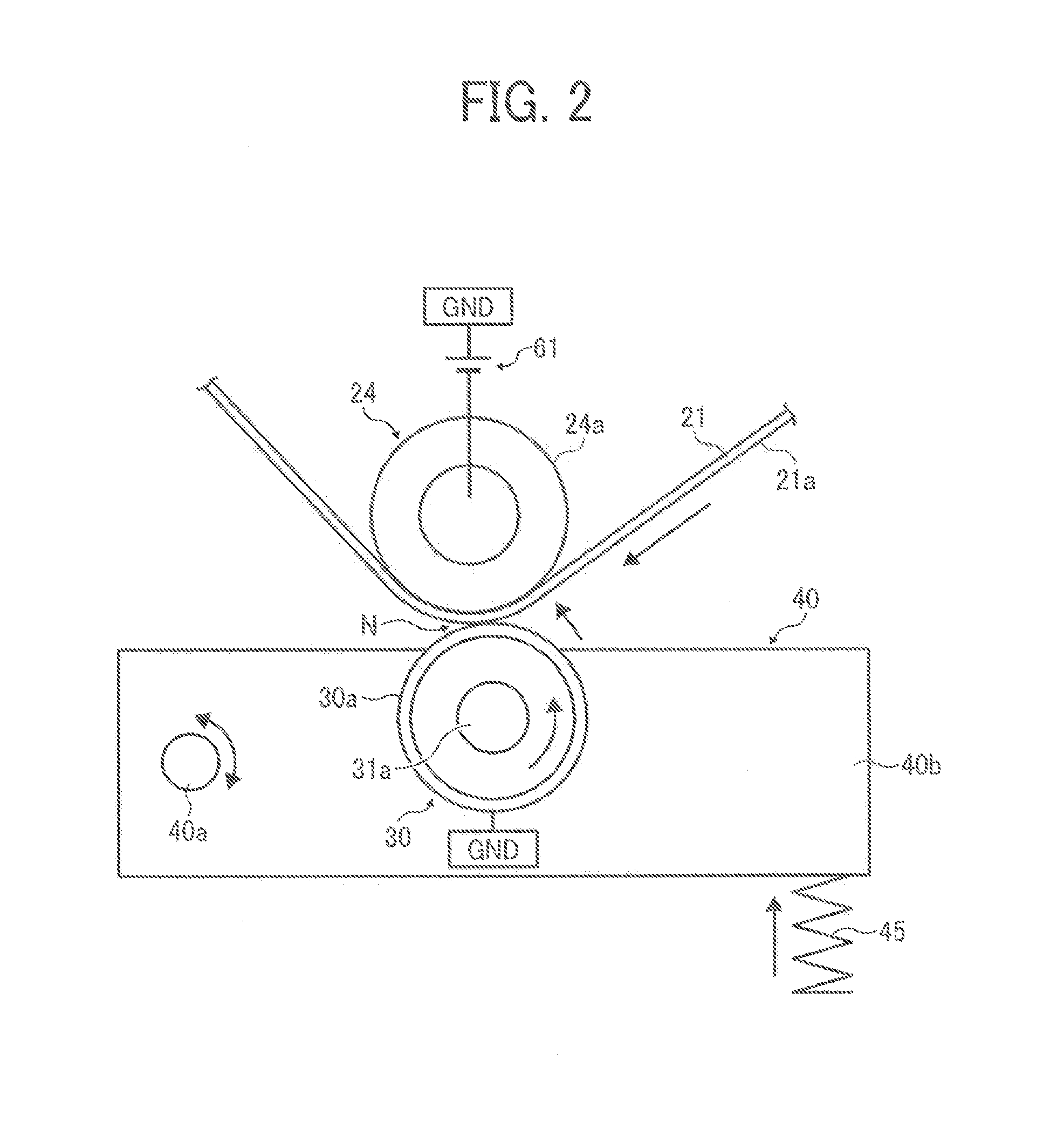Transfer device and image forming apparatus incorporating transfer device
a transfer device and image forming technology, applied in the direction of electrographic process apparatus, instruments, optics, etc., can solve the problems of -described conventional techniques cannot obtain a fine image, likely induced transfer error,
- Summary
- Abstract
- Description
- Claims
- Application Information
AI Technical Summary
Benefits of technology
Problems solved by technology
Method used
Image
Examples
first embodiment
[0063]As a device to resolve such a problem, a first embodiment is described with reference to FIG. 3, wherein an enlarged cross sectional view of surroundings of a secondary transfer nip N of the transfer unit 20 is described.
[0064]As shown, the secondary transfer roller 30 includes a roller section 31 extending in a widthwise direction perpendicular to that of a recording medium member conveyance, a pair of first and second shaft members 32 and 33 protruding from both ends and extending in a rotation shaft direction, and first and second idling rollers 34 and 35. The roller section 31 includes a hollow cylindrical metal core 31a, an elastic layer 31b overlying the circumference of the metal core 31a, and a surface layer 31c overlying the circumference of the elastic layer 31b.
[0065]Material of the metal core 31a includes stainless, aluminum, and the like, but is not limited thereto. The elastic layer 31b preferably has a prescribed JIS-A hardness equal to or less than about 70 de...
second embodiment
[0106]Now, a second embodiment, in particular an exemplary sequence of a recording medium, an image and a cam position is described with reference to FIG. 12.
[0107]Different from the first embodiment even with the same configuration, a separation amount is controlled in accordance with a thickness of a recording medium when an adjustment pattern is similarly formed between sheets. In this embodiment, the controller 600 controls an operation of a cam driving motor 58 and rotation of cams 50 and 51 such that cam positions changes in an order of A, B, C, and B.
[0108]An exemplary sequence of the recording medium having a basic weight of about 300 gmm2, an image, and a cam position is described. Initially, the cams 50 and 51 are located at a position A, so that the secondary transfer roller 30 and the belt surface 21a of the intermediate transfer belt 21 contact each other as shown in FIG. 11. Then, the cams 50 and 51 rotate and are located at the position B, serving as a separation posi...
third embodiment
[0119]Such a bias control is executed by a controller 600 that also controls a high voltage power source 61. Since a configuration of the apparatus and a time for applying a secondary transfer bias are the same to those in the third embodiment, description for them are omitted hereinafter, and a secondary transfer bias applied when an adjustment pattern is formed between sheets is only described.
[0120]FIG. 17 illustrates a sequence of a sheet, an image, a position of a cam, and a secondary transfer bias when two sheets of cardboard are fed in a system similar to that in the third embodiment. When image printing for the first sheet is completed, an adjustment pattern is formed corresponding to an interval between first and second sheets. Then, under a condition that the secondary transfer roller 30 contacts the secondary transfer opposed roller 24 via the intermediate transfer belt 21 and an image section current of −30 microA and −1000V of application voltage is applied, the first s...
PUM
 Login to View More
Login to View More Abstract
Description
Claims
Application Information
 Login to View More
Login to View More - R&D
- Intellectual Property
- Life Sciences
- Materials
- Tech Scout
- Unparalleled Data Quality
- Higher Quality Content
- 60% Fewer Hallucinations
Browse by: Latest US Patents, China's latest patents, Technical Efficacy Thesaurus, Application Domain, Technology Topic, Popular Technical Reports.
© 2025 PatSnap. All rights reserved.Legal|Privacy policy|Modern Slavery Act Transparency Statement|Sitemap|About US| Contact US: help@patsnap.com



